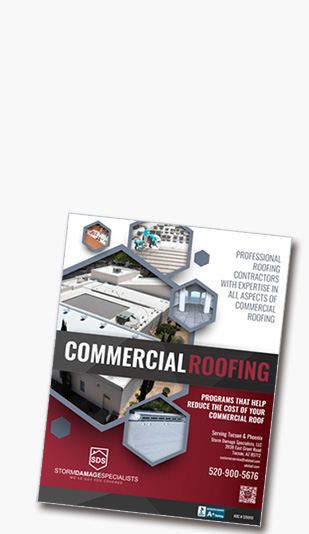Some signs of roof damage are easy to see, but what about the not-so-obvious signs? Roof issues aren’t always immediately noticeable. Early damage identification not only catches problems early, it assures that you can file a timely insurance claim if warranted, potentially saving you tens of thousands of dollars or more! Subtle roof damage can silently cause damage beneath the surface, leading to bigger and costlier problems if ignored. Hail or other storm damage can be subtle and require a trained eye to identify. Ignoring a minor surface leak can quickly turn it into a major problem.
The good news is that most of these warning signs can identify problems that can be easily fixed if detected early. After Tucson’s monsoon storms, you need to schedule a roof damage assessment even if you don’t see any immediate issues. At Storm Damage Specialists, our team has seen many roof emergencies that could have been prevented with a proactive inspection. These issues were often identified too late to file an insurance claim, further adding to the financial impact of the hail damage. Don’t let this happen to you—let’s look at the various types of roof damage you may have experienced and why it takes a professional to identify and rectify them before it’s too late.
Why Storm Damage Roof Inspections Are Necessary
Every year, the Tucson area is hit by dangerous storms. From wind and hail to heavy monsoon rains, these natural disasters can wreak havoc on the roofs of commercial and other buildings. Most of these storms occur during the spring and summer, so a professional inspection of your roof after storm season ensures any damage is detected and addressed.
Even the smallest damage left behind by these storms can lead to serious structural problems for your roof. That’s why it’s essential to have regular roof inspections during or after storm season, conducted by reliable and experienced roofing contractors like SDS.
To ensure the long-term health of your roof and avoid any potential dangers, schedule regular roof inspections during storm season. A professional roofing contractor will check for storm damage and perform a comprehensive inspection to identify any other maintenance or repair needs. If your roof is in poor condition, we may recommend a complete replacement and provide a detailed cost estimate.
Why It’s Important to Get Your Roof Inspected After a Storm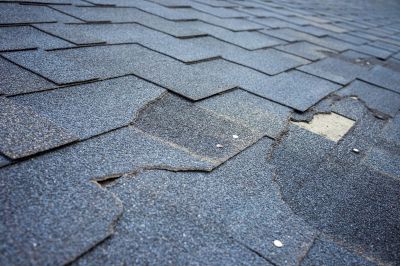
After a heavy storm, your roof can be vulnerable to damage from high winds, hail, and fallen trees. This damage may not be immediately noticeable but can lead to leaks and other issues down the line. That’s why getting a professional roof inspection is crucial. A small surface leak allows water to enter the roofing layers, leading to complete roof failure sooner than it should.
Assessing Damage
Our trained roof inspectors will identify any problems that may not be visible from the ground. They’ll check for missing roof shingles, tiles, indentations, damaged flashing, and other signs of damage you might miss.
Preventing Future Problems
A professional roof inspection can also help prevent future issues. If your roof has sustained significant hail damage, it can be more susceptible to leaks and future damage. By addressing these issues early, you can schedule roof repair or replace your roof before it further damages your building.
Saving Money
You can save money in the long run by getting a professional roof inspection from SDS. If you delay addressing the problem, the roof problems can worsen and become more expensive to fix. Early detection and repairs can prevent costly repairs or the need for an entirely new roof.
Types of Roof Damage
When it comes to roof damage, it’s not just holes and leaks that you need to worry about. With years of experience repairing and replacing roofs in the Pima County area, our SDS team has encountered all types of roof issues. Some are inevitable after a severe storm, while others can be avoided through proper maintenance.
While certain areas may be more prone to specific types of damage, these forms of roof damage are common in Arizona. Some may seem insignificant at first glance, but ignoring even the slightest damage can compromise the integrity of your roof in the long run.
Missing Shingles
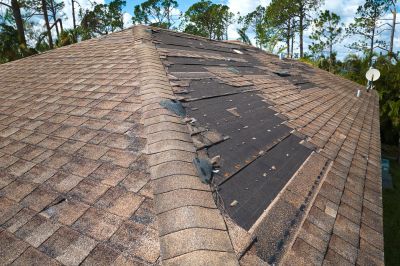 Look out for cracked, curling, or missing shingles—these are clear indicators that your roof has experienced significant hail damage.
Look out for cracked, curling, or missing shingles—these are clear indicators that your roof has experienced significant hail damage.
Spotting shingle damage from the ground can be tricky, so having a professional get on your roof might be necessary for a closer look. If wind damage is the culprit behind the missing shingles, you may have a viable insurance claim. But remember that improper installation can also cause shingles to go missing, in which case your options may be limited unless your workmanship warranty is still in effect.
Roof Decking Discoloration
After a storm, compromised roof decking poses serious risks such as mildew, mold, and structural damage caused by the weight of your roof. Unfortunately, identifying such damage is challenging without removing the old roof.
Nonetheless, if you observe rotten or discolored decking, it clearly indicates that you need a new roof or extensive repairs. Damaged roof decking suggests that water has penetrated the roofing materials, saturating the wood.
Possible causes include water seepage, faulty installation, or deteriorated roofing materials. If left unaddressed, widespread damage can lead to a roof collapse under excessive weight.
Missing or Damaged Flashing
Roof flashing uses waterproof strips to prevent leaks and safeguard vulnerable areas from water damage. Commonly installed near chimneys, vent pipes, skylights, or walls, roof flashing is sometimes called metal flashing due to its material.
Don’t overlook potential flashing damage—even some professional inspectors may miss loose or compromised materials that are still in place. Our roofers at SDS are particularly conscientious about identifying damaged flashing. In addition to flashing, gutters, and downspouts can also suffer dents, cracks, or breaks from hail damage.
Soft Spots
Soft spots on your roof can lead to serious damage if left untreated. These weak spots occur when moisture seeps into the underlying decking, causing it to deteriorate. While missing or damaged shingles are often the main cause, damaged flashing and clogged gutters can also contribute to soft spots. If left unchecked, the roof decking may sag, leading to visible low spots on the roof and potential water damage to your building’s interior.
Regular inspections and maintenance can help catch soft spots early on. By having SDS inspect your roof annually, you can identify and address any soft spots before they become a major issue. Spot repairs are much more cost-effective than a full roof replacement.
Interior leaks
Don’t let a minor leak on your ceiling deceive you—it could be the start of a major problem. Water damage can cause rot and make your roof more prone to future leaks. Cracked shingles and granule-filled gutters are telltale signs of roof water damage.
A leaky roof can result in water damage in your ceiling or attic, leading to additional problems. The first step to preventing water damage from roof leaks is recognizing when your roof is leaking and finding the source. During our inspections, we look for residue on nearby materials, even in hard-to-see areas. Excessive moisture is often an early sign of roof damage. This will help pinpoint the exact location of the roof leak damage.
Typically, undamaged ceilings are straight and solid. If you notice any cracks (straight or angular, resembling a spider’s web) or a sagging or crooked ceiling, your roof may have an underlying issue. Once water starts seeping into your building, call SDS immediately.
Assessing Damage on Different Roof Types
Different types of roofing materials will show hail damage differently. SDS has experience with all types of commercial roofs and we know what to look for after a storm.
Metal Roofs
When determining wind damage to a metal roof, we look for:
- Alignment of main frame columns
- Sagging in the roof and wall bracing (steel cables or flat straps)
- Squareness of door openings
- Signs of lifting near the ridge and eave strut of metal roof panels
The visible ‘X’ bracing is a valuable indicator of damage if not covered by insulation. These cables or straps should be under tension, so if they are loose, it suggests the building has been displaced.
Flat Roofs
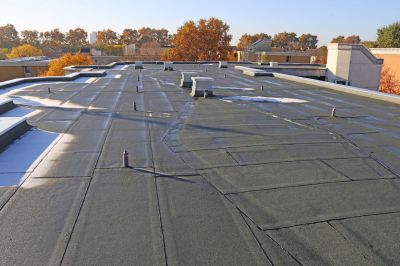
Wind uplift can occur when wind gets beneath the flat roofing materials and lifts them up. Wrinkles or bubbles on a flat roof indicate the materials are no longer secure. Therefore, wind uplift can cause rain, snow, and debris to penetrate the roof.
We understand the impact of strong winds on roofs and have strategies to minimize wind uplift. We secure metal edge flashing and ensure the strength of the roof fascia to prevent damage. SDS will inspect the fascia and flashing to detect problems and promptly schedule roof repair if needed.
Wind scouring is another destructive force that flat roofs face. It occurs when strong winds strip away granules or gravel from the roof’s surface. Unlike wind uplift, wind scouring may not be immediately noticeable and can lead to significant damage if left unaddressed.
Asphalt-shingled Roofs
Made with a sealant, fiberglass, asphalt, and granules, asphalt shingles are designed to withstand varying temperatures and weather conditions. However, strong winds can cause damage to asphalt roofs, particularly along the perimeter of the roof. While the center of the roof may also sustain damage, it typically experiences slightly less wind pressure than the edges.
When wind flows across the roof, it has the potential to bend, detach, or completely dislodge shingles. In addition to direct damage from wind, debris blown around by winds can also cause problems for asphalt shingles. Tree branches, glass fragments, and other objects can puncture or scratch the shingles, leading to the need for repairs or replacements.
When shingles become detached from the roof, they can be manually removed. Over time, some shingles may become completely unattached, while others may only be partially detached, as repeated exposure to wind weakens their bond to the roof.
Wind uplift can cause shingles to bend, with the extent of bending depending on the speed, direction, and strength of the wind. This repeated bending weakens the asphalt shingles over time.
Missing shingles are a sign of weakened bonds caused by wind or improper installation. If you notice any of these signs of damage, it may be time to repair or replace your asphalt roof.
Tile Roofs
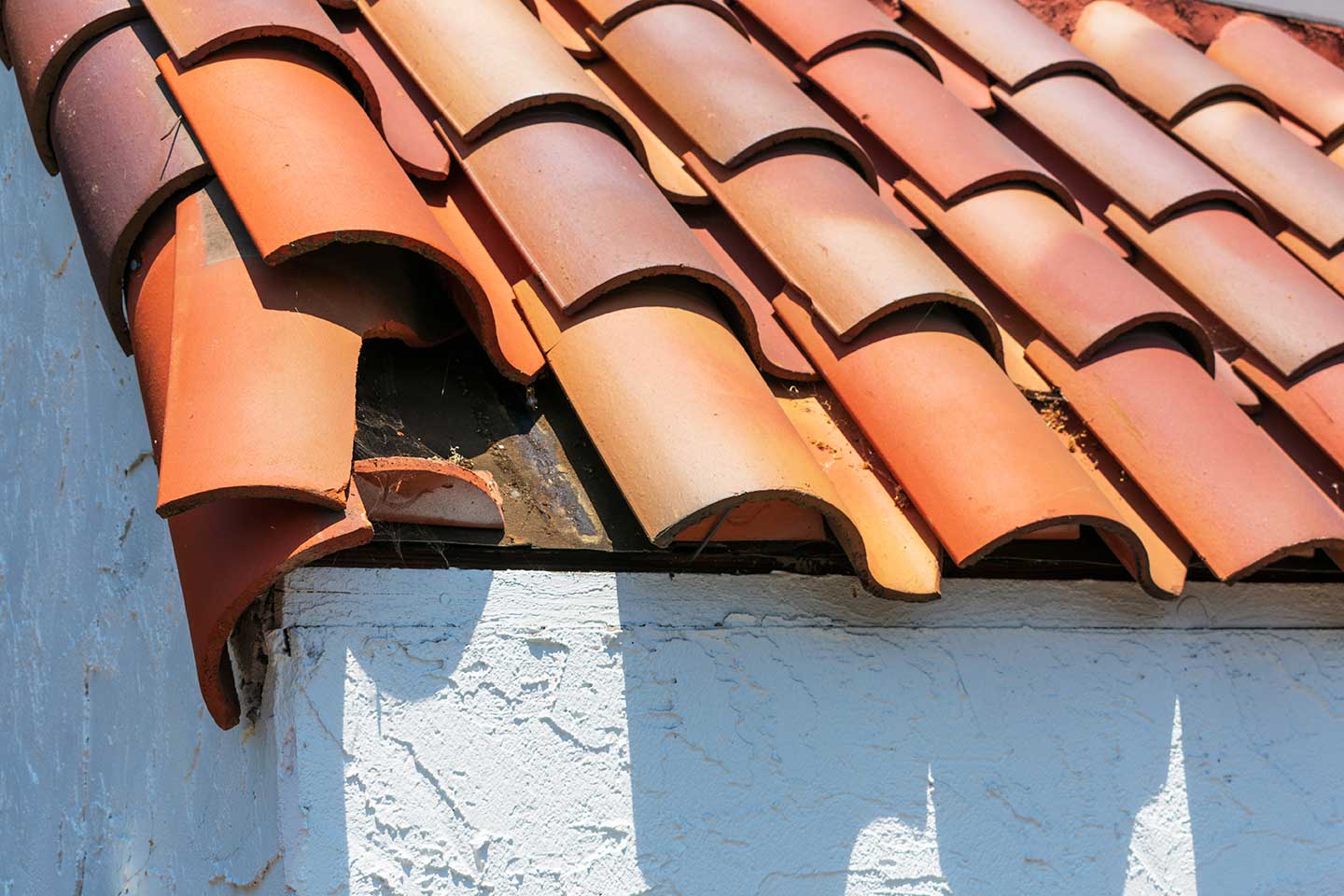 Concrete and clay roof tiles can experience wind, hail, mechanical, and wear/tear damage. Misinterpreting these types of damage is a common issue in the field with less experienced roofers.
Concrete and clay roof tiles can experience wind, hail, mechanical, and wear/tear damage. Misinterpreting these types of damage is a common issue in the field with less experienced roofers.
High winds can cause tiles to become displaced, go missing, or break from debris impact. This is most often seen along the roof’s perimeter and on ridges and hips where wind pressures are strongest. Displaced tiles are typically lifted by the wind and not set back in their original locations.
Other types of damage, such as broken corners and detached ridge and hip tiles, are often caused by mechanical factors, hail strikes, or improper installation. Additionally, broken corners can result from shipping or handling issues that may not be noticed during installation. Detached ridge and hip tiles, on the other hand, are a result of long-term wear and tear on the mortar used to attach the tiles.
What is Checked During a Roof Inspection?
There is more to a roof inspection than you may realize. SDS focuses on these key points to identify common roofing issues:
- Pipe boots and roof penetrations: We check for cracks and wear around these areas to ensure a proper seal and prevent leaks.
- Metal flashings: Attention is given to rust, damage, or detachment of flashings that redirect water away from critical areas.
- Chimney masonry: The integrity of the chimney’s masonry is assessed, looking for cracks, deterioration, and effective waterproofing.
- Valleys: Evaluating the condition of valleys helps identify wear, damaged shingles, and debris accumulation that could impact water flow.
- Roof decking: Checking for sagging or water damage in the foundation of your shingles is essential for a strong roof structure.
- Rusted nails and popped shingles: These compromise your roof’s protection, so we look for signs and recommend action.
- Skylights: The seals on skylights are inspected to prevent any potential leaks.
- Ventilation: We check for blocked roof vents, proper airflow, and excessive moisture to maintain a healthy roof.
- Eaves and overhang: Inspection for water damage, rot, or pest infestations in these vulnerable areas is crucial for roof integrity.
- Fascia and soffit: Assessing these components for water damage and pests maintains airflow and protects your roof’s edges.
- Gutters: Properly functioning gutters are important for water drainage, so we inspect for clogs and misalignment.
- Missing or damaged shingles: Cracked, curled, torn, or missing shingles need prompt replacement to protect your roof.
- Algae-stained shingles: Discolored or streaked shingles caused by algae growth are addressed through cleaning or preventive measures.
Experience and Expertise: Why Hiring a Professional Roof Inspector is Crucial
When it comes to your roof, it pays to have the expertise and experience of a professional inspector. To ensure your safety, it’s best to leave the inspection to the professionals rather than attempting to climb onto your roof.
Storm Damage Specialists are certified and stay up-to-date with industry standards and regulations. From traditional shingle or tile roofs to metal roofs and built-up roofs, we possess comprehensive knowledge of all types of roofing. Our expertise means we can quickly and accurately evaluate any roof wind or hail damage, ultimately saving you time and money in the long run.
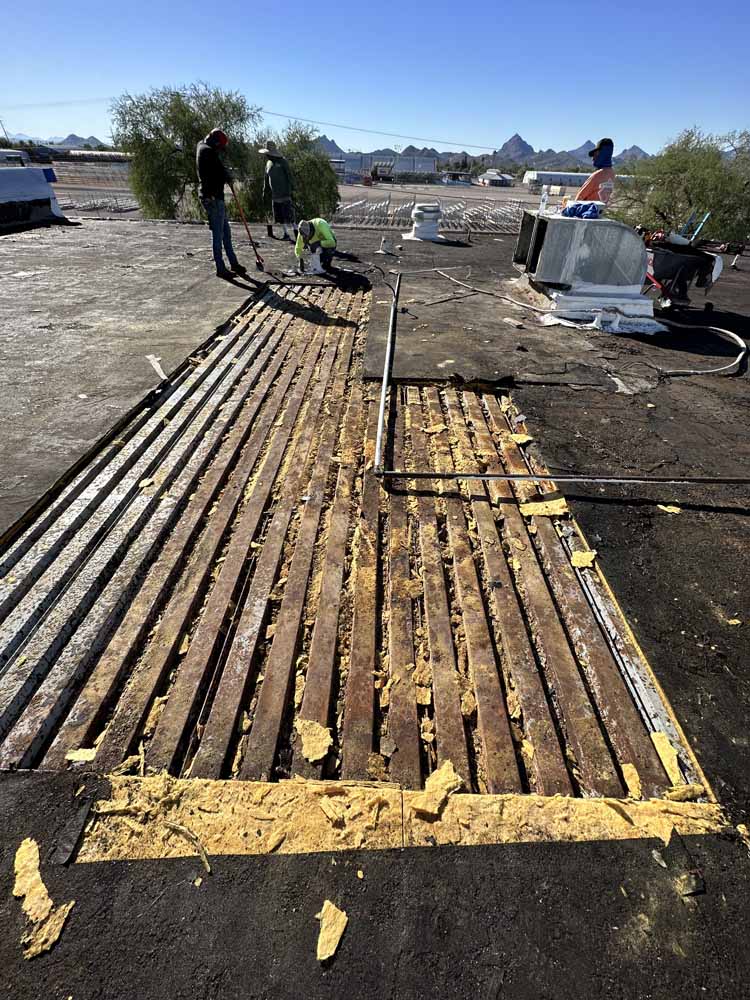
Our roofers leave no stone unturned when evaluating your property’s roofing system. We take accurate measurements and generate comprehensive reports, complete with high-quality photos of any areas requiring attention or repair. These reports are invaluable to your insurance company for storm damage repairs or replacement claims.
Although hiring a professional roofing contractor may initially seem like an added expense, it is actually one of the best investments you can make after a storm. By promptly addressing existing issues, you can prevent major problems in the future. Additionally, having an accurate report from a qualified expert simplifies the insurance claim process for hail damage repairs. Don’t overlook the importance of a professional roof inspection. It’s crucial to choose a reliable and experienced roofing contractor like SDS. We have years of experience and a skilled team to back up our service guarantees. We have the knowledge and expertise to accurately assess your roof’s condition after every storm, or at the end of the storm season. Don’t settle for anything less than the best when protecting your commercial or industrial property.
Roof Damage Insurance Claims
If your roof suffered hail damage, you have limited time to file an insurance claim. Each insurance policy allows for a specific timeframe to file a claim after a weather event or loss occurs. It can range from 6 months to 2 years, but on average it’s around 1 year. Check your policy to know your exact timeline.
Remember, insurance companies have access to hail maps to determine if your building was affected and when the storm occurred. That’s why filing a claim as soon as you become aware of the hail damage is crucial.
SDS has extensive experience navigating the insurance claim process. Don’t try to handle your insurance company alone and risk losing the payment you deserve.
Get Prepared With SDS
Don’t let last summer’s hail storms become this winter’s roof emergency. Team up with SDS professionals and ensure serious roof damage doesn’t get overlooked with a free inspection. Contact us today and avoid paying for a new roof tomorrow!

